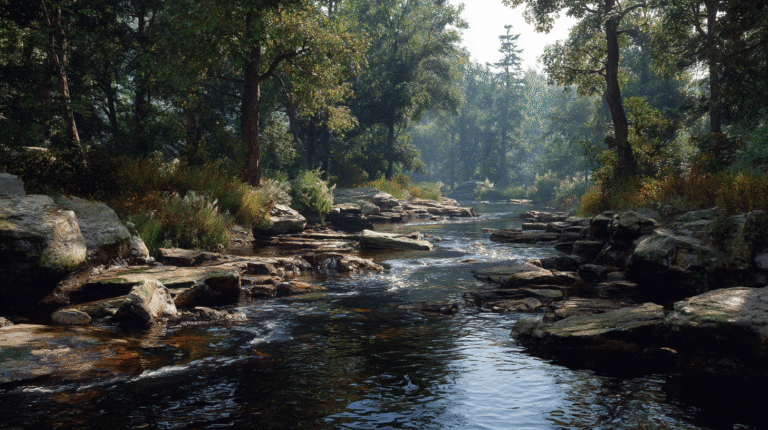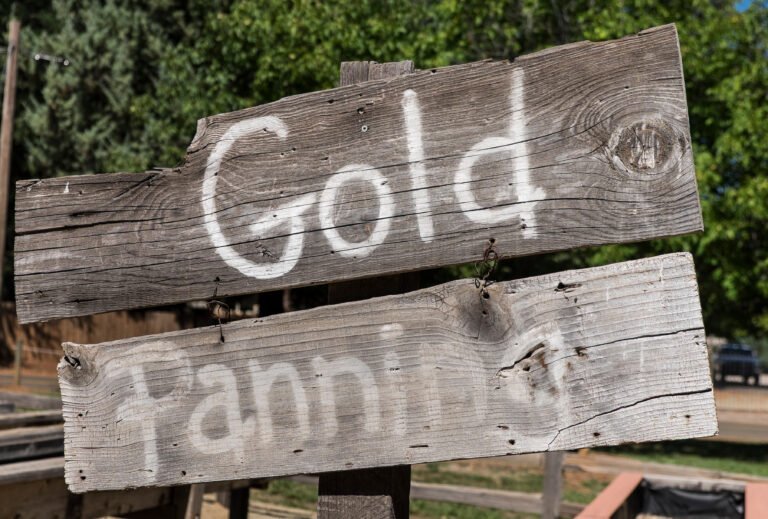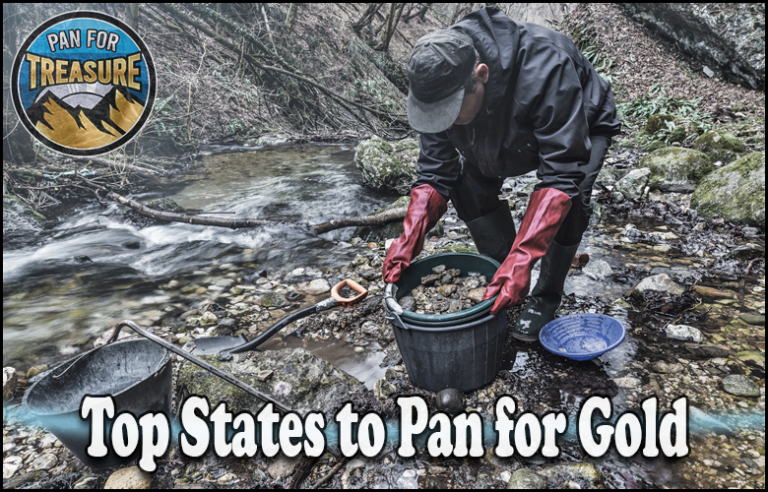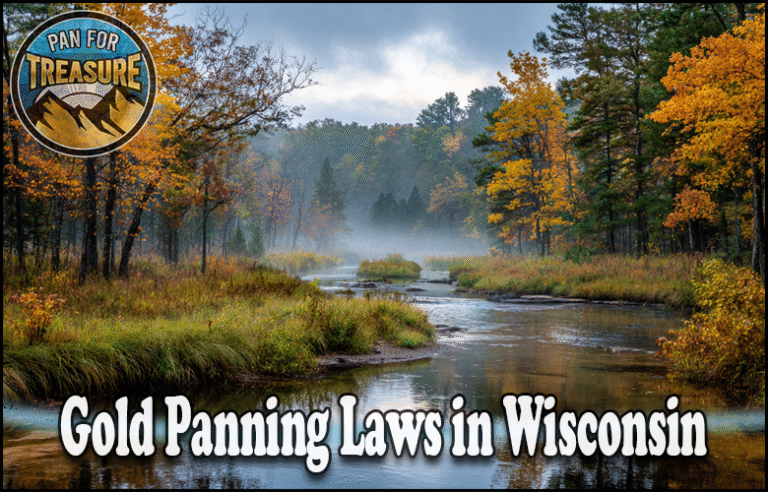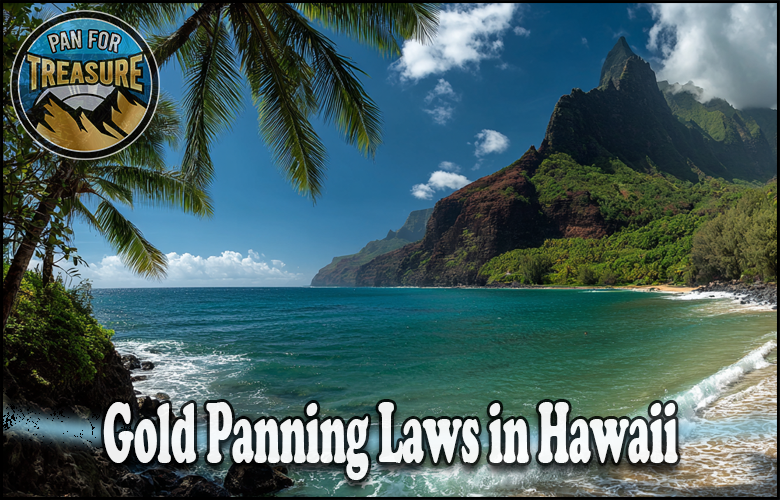
Disclosure: This Post Contains Affiliate Links; We earn a commission on purchases.
When it comes to gold panning in Hawaii, understanding the laws and regulations is crucial for both the enjoyment of your experience and staying on the right side of the law.
Hawaii’s beautiful landscapes and rich history make it an exciting destination for gold prospectors, but it’s important to know the rules before you start digging.
Key Takeaways
- Recreational gold panning in Hawaii is allowed on public lands with the proper permits from the Department of Land and Natural Resources (DLNR).
- Commercial mining operations require separate permits and approvals.
- Respect boundaries and seek permission when panning on privately-owned property.
- Follow guidelines and regulations to protect the environment and cultural heritage.
- Some of the best locations for legal gold panning in Hawaii include the Wailua River, Waipio Valley, and the Ko’olau Mountains.
Is Gold Panning Legal in Hawaii?
Recreational gold panning in Hawaii is a legal activity, but it is subject to specific regulations and guidelines to ensure the protection of the environment and cultural heritage. It is important for prospectors to understand and comply with these laws to engage in gold panning legally.
The Department of Land and Natural Resources (DLNR) issues permits for recreational gold panning on public lands in Hawaii. These permits are required to engage in gold panning activities and serve as proof of compliance with the regulations. Without a permit, gold panning on public lands is considered illegal.
Commercial mining operations, on the other hand, require separate permits and approvals, and they must adhere to additional regulations set forth by the DLNR and other relevant authorities.
By obtaining the necessary permits and following the regulations, gold panners can enjoy their hobby while minimizing any negative impact on the environment or cultural sites. It is crucial to respect boundaries and seek permission from landowners when panning on private property to avoid trespassing or violating any legal agreements.
Where Can You Pan for Gold Legally in Hawaii?
If you’re looking to try your hand at gold panning in Hawaii, there are several legal locations where you can pursue this adventurous activity. Here are some of the best places for gold prospecting in the islands:
| Location | Description |
|---|---|
| Wailua River, Kauai | The Wailua River on the island of Kauai is known for its rich gold mining history. It offers prospectors the opportunity to pan for gold amidst stunning natural beauty. |
| Waipio Valley, Big Island | Waipio Valley on the Big Island is another picturesque spot for gold panning. This lush valley provides a serene setting as you search for the glittering treasures. |
| Ko’olau Mountains, Oahu | The Ko’olau Mountains on Oahu offer a unique gold prospecting experience. With breathtaking panoramic views, you can enjoy the thrill of finding gold in the heart of the island. |
These locations not only provide the opportunity to pan for gold legally but also immerse yourself in Hawaii’s gold mining history. Remember to obtain the necessary permits and follow all regulations to ensure a responsible and enjoyable gold panning experience.
Exploring the Wailua River
The Wailua River on the island of Kauai is a popular destination for gold panning enthusiasts. Its serene waters and lush surroundings make it an ideal spot to immerse yourself in nature while searching for gold. Make sure to bring your gold pan and other necessary equipment, and enjoy the thrill of prospecting along this historic river.
Related Gold Panning Information
Tips for Successful Gold Prospecting in Hawaii
Embarking on a gold panning adventure in Hawaii requires careful preparation and knowledge. To ensure a successful and rewarding experience, consider the following tips and guidelines:
1. Research and Gather Information
Prior to heading out to prospect for gold in Hawaii, it is crucial to research and gather essential information about the best prospecting areas, local regulations, and any restrictions that may apply. Familiarize yourself with the specific guidelines set by the Department of Land and Natural Resources (DLNR) to ensure compliance with gold panning laws in Hawaii.
2. Choose the Right Equipment
Investing in the right tools and equipment is key to successful gold prospecting in Hawaii. Some essential items to consider include a gold pan, classifier, shovel or trowel, snuffer bottle, magnifying glass, and gloves. Quality equipment will enhance your effectiveness and efficiency in finding gold.
3. Learn Proper Panning Techniques
Take the time to learn and practice proper panning techniques. This includes understanding how to properly shake the pan to separate lighter materials from the gold, how to spot potential gold deposits, and how to recover any gold found. Learning from experienced prospectors or joining a gold panning club can provide valuable guidance and instruction.
4. Be Patient and Persistent
Gold prospecting in Hawaii requires patience and persistence. Don’t get discouraged if you don’t strike gold immediately. Gold deposits can be elusive, and it may take time to find the right spot and technique. Stay committed, explore different locations, and refine your skills for better chances of success.
5. Respect Nature and Follow Regulations
When engaging in gold panning activities in Hawaii, it’s crucial to respect the environment and follow all regulations and guidelines. Leave the area as you found it, pick up any trash, and avoid damaging the surrounding ecosystem. Additionally, always obtain the necessary permits and permissions to pan in specific areas.
Remember, successful gold prospecting is a combination of research, preparation, skill, patience, and respect. By following these tips and guidelines, you increase your chances of a rewarding and responsible gold panning experience in the beautiful islands of Hawaii.
Public vs. Private Areas for Gold Panning in Hawaii
In Hawaii, gold prospectors have the opportunity to explore both public and private areas for their gold panning adventures. Each option offers its own unique advantages and considerations.
Gold Panning on Public Land
Public lands in Hawaii provide easy access for anyone interested in trying their hand at gold prospecting. Aspiring prospectors can explore designated public areas that are open for recreational gold panning. These areas are typically managed by government agencies such as the Department of Land and Natural Resources.
- Public lands offer a wide range of locations throughout the islands, allowing prospectors to explore different environments and increase their chances of finding gold.
- Accessing public gold panning areas usually requires obtaining a permit from the respective land management agency, such as the Department of Land and Natural Resources.
- It’s essential to follow all rules and regulations governing public land use, including any restrictions on digging, equipment use, and environmental conservation.
- Respecting the environment and leaving the public areas as you found them is crucial to preserving the natural beauty and ensuring the sustainability of gold panning activities.
Legal Access for Gold Prospecting on Private Land
In addition to public lands, gold prospectors in Hawaii also have the option of exploring private areas for their gold panning ventures. Private landowners or gold panning tour operators may provide access to exclusive locations that offer a more personalized experience.
- Prospecting on private land requires obtaining permission from the respective landowner or securing a spot on a guided gold panning tour.
- Private gold panning tours often come with knowledgeable guides who can provide valuable insights and assistance to enhance your gold prospecting skills.
- When accessing private areas, it’s important to adhere to any rules or regulations set by the landowner or tour operator, which may include specific instructions for panning techniques and environmental preservation.
Regardless of whether you choose to pan for gold on public or private land in Hawaii, it’s crucial to always obtain the necessary permissions and adhere to any rules and regulations. This ensures a responsible and sustainable gold panning experience that respects both the environment and the rights of landowners.
| Pros of Public Land | Cons of Public Land |
|---|---|
| Wide range of locations throughout the islands | Need to obtain a permit |
| Easy access for anyone interested in trying gold panning | Rules and restrictions governing public land use |
| Opportunity to explore different environments | Importance of environmental conservation |
| Pros of Private Land | Cons of Private Land |
|---|---|
| Potential for exclusive access to gold-rich areas | Need to obtain permission from landowners |
| Guided gold panning tours with knowledgeable guides | Adhering to specific rules and regulations set by landowners |
| Personalized experience tailored to individual needs | Respecting landowner rights and environmental preservation |
Remember, whether you choose to pan for gold on public or private land, always prioritize responsible gold panning practices and adhere to any regulations to ensure a sustainable and enjoyable experience.
Essential Equipment for Gold Panning in Hawaii
In order to embark on a successful gold panning adventure in Hawaii, it’s essential to have the right tools at your disposal. The following equipment is recommended for gold prospecting in Hawaii:
- Gold Pan: A sturdy gold pan is a must-have tool for capturing and separating gold particles from other materials.
- Classifier: Use a classifier to sift through larger rocks and debris, allowing you to focus on the finer materials that may contain gold.
- Shovel or Trowel: A durable digging tool is essential for loosening soil and extracting material for gold panning.
- Snuffer Bottle: A snuffer bottle with a thin nozzle is perfect for sucking up small gold flakes or nuggets from your pan.
- Magnifying Glass: Enhance your gold panning experience by examining your findings closely with a magnifying glass. It will help you identify smaller specks of gold.
- Gloves: Protect your hands from rough rocks and potential hazards by wearing a sturdy pair of gloves.
Investing in quality equipment ensures the effectiveness of your prospecting efforts in Hawaii. The right tools will make it easier to separate and capture gold, increasing your chances of success.
“Having the right tools for gold panning in Hawaii is crucial for a productive and enjoyable experience. Don’t underestimate the importance of investing in quality equipment – it can truly make a difference.”
Gold Prospecting History and Sites in Hawaii
Hawaii has a fascinating history of gold mining, with the islands hiding significant deposits and boasting several historic mining sites. These sites provide a captivating glimpse into the state’s mining heritage and the gold rush that once swept through the region.
One notable historic gold mining site in Hawaii is the Halawa Manganese Mine. Located on the island of Molokai, this mine played a crucial role in the state’s mining industry during the early 20th century. It was primarily focused on extracting manganese, an essential mineral used in steel production.
The Kauai Sulfur Mine is another significant mining site in Hawaii. Located on the island of Kauai, this mine was once a major sulfur producer and contributed to the economic growth of the region. The mining operations at Kauai Sulfur Mine were active in the late 19th and early 20th centuries.
Exploring these historic mining sites allows visitors to connect with Hawaii’s rich mining past and witness the remnants of the gold rush era. Walking through the abandoned mines and imagining the bustling activity that once took place is a truly captivating experience.
Aside from these specific sites, Hawaii is known to have other significant gold deposits scattered across the islands. Although gold mining is not as prevalent as it once was, the allure of finding traces of gold in the volcanic soil continues to attract enthusiasts and prospectors.
Whether you’re a history buff or simply fascinated by the idea of uncovering gold in a tropical paradise, exploring the gold prospecting history and sites in Hawaii promises an unforgettable adventure.
Gold Prospecting Clubs and Tours in Hawaii
Joining a gold prospecting club in Hawaii can offer a wealth of benefits for both newcomers and experienced enthusiasts. These clubs provide opportunities to learn more about gold panning techniques, network with like-minded individuals, and gain access to exclusive prospecting areas. Whether you’re a beginner looking to acquire new skills or a seasoned prospector seeking camaraderie, Hawaii has a range of clubs and tours to suit your needs.
Hawaiian Gold Prospectors Association (HGPA)
The Hawaiian Gold Prospectors Association (HGPA) is the oldest and largest gold prospecting club in Hawaii. Established in 1982, the HGPA is dedicated to promoting responsible and sustainable gold panning practices while preserving the state’s natural resources. As a member, you’ll have access to educational resources, group outings, and expert guidance from experienced prospectors. The club also hosts regular meetings and events where members can share their knowledge and experiences.
Maui Gold Seekers
If you’re in Maui, the Maui Gold Seekers is a great club to consider. This club offers beach outings and panning activities suitable for beginners and those looking for a more relaxed prospecting experience. The Maui Gold Seekers provide equipment rentals and offer training sessions to help you get started on your gold panning journey. Besides gold prospecting, the club also organizes various social events and community initiatives, fostering a sense of togetherness among its members.
Gold Panning Tours in Hawaii
If you prefer guided tours or want a more structured gold panning experience, several companies in Hawaii offer gold panning tours. These tours are led by knowledgeable guides who will provide you with all the necessary equipment and teach you the basics of gold panning. Along with panning for gold, you’ll learn about Hawaii’s rich gold mining history and the local flora and fauna. It’s a great way to combine adventure with education and discover the hidden treasures of Hawaii.
| Club/Company | Location | Membership/ Tour Details |
|---|---|---|
| Hawaiian Gold Prospectors Association (HGPA) | Statewide |
|
| Maui Gold Seekers | Maui |
|
| Various Gold Panning Tour Companies | Islandwide |
|
Joining a gold prospecting club or going on a gold panning tour in Hawaii not only allows you to pursue your passion for gold prospecting but also provides opportunities to connect with other enthusiasts and learn from experienced individuals. Whether you choose to join the HGPA, the Maui Gold Seekers, or go on a guided tour, the adventures and discoveries await.
Discovering More than Gold in Hawaii
Hawaii offers more than just gold panning opportunities. The cultural treasures, rich traditions, historical sites, and local stories are just as valuable as gold.
Exploring Hawaii’s heritage goes beyond the search for gold. By immersing yourself in the vibrant culture of the islands, you can gain a deeper understanding and appreciation of the unique history and traditions that make Hawaii truly special.
Immerse yourself in the rich history
From ancient Hawaiian legends to significant historical landmarks, Hawaii is a treasure trove of stories waiting to be discovered. Visit museums, like the Bernice Pauahi Bishop Museum, which showcases the history and culture of Hawaii. Explore the Iolani Palace, the only royal palace in the United States, and learn about the monarchy that once ruled these islands.
Attend cultural festivals and events
Experience the vibrant spirit of Hawaii by attending cultural festivals and events. The Merrie Monarch Festival, held annually in Hilo, celebrates the art of hula and showcases traditional Hawaiian dance and music. The Aloha Festivals, held on various islands throughout the year, offer a glimpse into the diverse cultures that have shaped Hawaii.
Engage with the locals
One of the best ways to discover Hawaii’s heritage is by engaging with the friendly locals. Take the time to talk to the people you meet, ask questions, and listen to their stories. They can provide valuable insights into the traditions, language, and customs that have been passed down through generations.
“The cultural heritage of Hawaii is a treasure that surpasses any gold found in its streams. It’s in the people, the traditions, and the stories that have been preserved throughout the centuries.”
Preserving Hawaii’s legacy
As you delve into Hawaii’s heritage, it’s important to remember the responsibility we have in preserving and respecting the cultural treasures of this beautiful state. Leave no trace, follow any guidelines or restrictions in cultural areas, and ensure your interactions with local communities are respectful and appreciative.
| Historical Site | Location |
|---|---|
| Halawa Manganese Mine | Molokai |
| Kauai Sulfur Mine | Kauai |
| Pu’u O Mahuka Heiau | Oahu |
By exploring these historic sites and engaging with the local community, you can gain a deep appreciation for Hawaii’s cultural heritage beyond the pursuit of gold.
Conclusion
Gold panning in Hawaii offers a unique and exciting opportunity to explore the islands’ hidden treasures. With the proper permits and adherence to regulations, prospectors can enjoy a fulfilling and law-abiding gold panning experience. Understanding the laws is crucial to ensure compliance and protect the environment and cultural heritage of Hawaii.
While striking it rich may not be guaranteed, the adventure and beauty of Hawaii make every moment worthwhile. Whether you’re exploring the historic mining sites or panning in the picturesque rivers and valleys, the thrill of the hunt and the serene surroundings create an unforgettable experience.
Summary of gold panning in Hawaii:
– Obtain the necessary permits from the Department of Land and Natural Resources (DLNR) to engage in recreational gold panning on public lands.
– Follow regulations and guidelines to protect the environment and cultural heritage.
– Explore legal gold panning locations such as the Wailua River, Waipio Valley, and Ko’olau Mountains for the best chances of finding gold.
– Equip yourself with the essential tools and learn proper techniques for successful gold prospecting.
Remember, Hawaii is not just about gold panning. Immerse yourself in the rich culture and history of the islands, attend cultural festivals, and engage with the locals to discover the true treasures of Hawaii. Whether you strike it rich or not, the memories and experiences gained from gold prospecting in Hawaii will last a lifetime.
Source Links
- https://howtofindrocks.com/gold-prospecting-in-hawaii/
- https://ulhund.com/blogs/beginner-guid/usa-metal-detecting-laws-by-state-know-the-regulations-for-treasure-hunting

Meet Ryan Conlon, the passionate owner and driving force behind Pan for Treasure.
With an unwavering love for the art of gold panning, Ryan has transformed his enthusiasm into a thriving community hub for fellow treasure seekers. [email protected]
A seasoned gold panning enthusiast, Ryan’s journey began with a simple pan and a dream, evolving into a deep appreciation for the history, geology, and thrill of uncovering precious metals.
Subscribe to Our Newsletter

